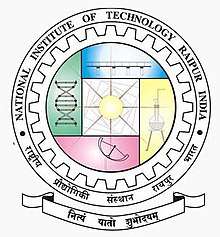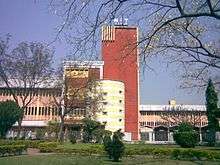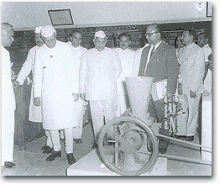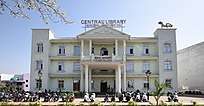National Institute of Technology, Raipur
|
राष्ट्रीय प्रौद्योगिकी संस्थान, रायपुर | |
 | |
Former names |
|
|---|---|
| Motto | नित्यं यातो शुभोदयं |
Motto in English | Let the rise of goodness happen every day |
| Type | Public |
| Established | 1956 |
| Director | A.M. Rawani |
| Undergraduates | 955 |
| Location | Raipur, Chhattisgarh, India |
| Campus | Urban |
| Colours | Blue |
| Website |
www |
National Institute of Technology, Raipur (abbreviated NIT Raipur or NITRR), is a premier public engineering and research institution located in Raipur, Chhattisgarh, India. Founded in 1956 with two engineering disciplines, mining and metallurgy, the institute is one of the oldest institute in National Institutes of Technology system. It is recognized as an Institute of National Importance by the Government of India under the National Institutes of Technology Act, 2007.[1]
History
The first President of India, Rajendra Prasad laid the foundation stone of the college building on 14 September 1956. Construction was completed in 1962 and the college was inaugurated on 14 March 1963 by the first Prime Minister of India, Jawaharlal Nehru.
Until as late as 1956, there were only three technical institutes in the country devoted to mining and metallurgical engineering. In view of this fact and also with the aim of harnessing the ample mineral resources in the region, the institute was set up on 1 May 1956 as Government College of Mining and Metallurgy. The first session of the college commenced on 1 July 1956 with the admission of 15 students each in mining and metallurgical engineering.[2]


In 1958–59 with the commencement of additional courses in civil, mechanical and electrical engineering, the college came to be known as Government College of Engineering and Technology. Later graduate courses in chemical engineering (1965), architecture (1984), electronics (1985), information technology, computer science and technology (2000), biotechnology and biomedical engineering (2003) were started. It was declared a National Institute of Technology (NIT) by the Government of India on 1 December 2005 and then declared an Institute of National Importance with the passing of the National Institutes of Technology Act, 2007, in May 2007.[3]
Administration
The President of India is the ex officio visitor of all the National Institutes of Technology (NITs). The National Institutes of Technology Council (NIT Council) works directly under him and it includes the minister-in-charge of technical education in Central Government, the Chairmen and the Directors of all the NITs, the Chairman of University Grants Commission (India), the Director General of Council of Scientific and Industrial Research, the Directors of other selected central institutions of repute, members of Parliament, Joint Council Secretary of Ministry of Human Resource Development, nominees of the Central Government, All India Council for Technical Education and the Visitor.
Below the NIT Council is each NIT's Board of Governors. The Board of Governors of each NIT consists of the chairman and ten members, which include government, industry, alumni and faculty representation.
The Director serves under the Board of Governors, and is the school's chief academic and executive officer. Academic policies are decided by its Senate, which is composed of some professors and other representatives. The Senate controls and approves the curriculum, courses, examinations, and results. Senate committees examine specific academic matters. The teaching, training, and research activities of various departments of the institute are periodically reviewed to maintain educational standards. The Director is the ex officio Chairman of the Senate. The Deputy Director is subordinate to the Director. Together they manage the Deans, Heads of Departments, Registrar, President of the Students' Council, and Chairman of the Hall Management Committee. Deans and Heads of Departments in NITs are administrative postings rather than career paths. Faculty members serve as Deans and Heads of Departments for limited periods, typically 2 to 3 years, then returning to regular faculty duties. The Registrar is the chief administrative officer and overviews day-to-day operations. Below the Head of Department, are the various faculty members (professors, assistant professors, and lecturers). The Warden serves under the Chairman of the Hall Management Committee.[4]
Admission
- Admission to the undergraduate programmes is highly competitive and is based on the rank secured in the Joint Entrance Examination (Main). Candidates must also secure at least 75% marks in the 12th class examination, or be in the top 20 percentile in the 12th class examination conducted by the respective Boards. For Scheduled Castes/Scheduled Tribes students, the qualifying marks would be 65% in the 12th class examination. The Joint entrance exam (Main) is considered to be one of the toughest examinations in the world.[5]
- NIT Raipur follows the reservation policy declared by the Supreme Court of India, by which 27% of seats are reserved for Other Backward Classes, 15% for Scheduled Castes, and 7.5% for Scheduled Tribes. The institute also accepts foreign nationals through scholarships awarded by the Government of India, and non-resident Indians through an independent scheme known as Direct Admission for Students Abroad that uses SAT scores.[6]
- Admissions to the postgraduate programmes are through the Graduate Aptitude Test in Engineering for the Master of Technology (M.Tech.) and Master of Science programs (taught and research), and through NIMCET for the Master of Computer Applications (M.C.A) program.[7]
Academics
The institute is committed to the challenging task of development of technical education by preparing seasoned graduates in highly sophisticated field of engineering and technology. Development of India as an emerging industrial power is a demanding exercise as it involves the combination of cost effectiveness and efficiency along with producing world-class technology at the cutting edge. At present the institute offers graduate level courses in twelve disciplines.[8]
The institute currently houses the following departments:[8]
| Engineering | Other Departments |
|---|---|
| Science | Architecture |
Student Life
Campus
The Institute has a well - organized, magnificent building symbolizing the grandeur of the institute. This huge building alone covers a total area of 62060 sq.m. It is a triple storied planned structure along with a central tower standing up to the height 23 meters. There are 35 lecture halls extending over an area of 6675 sq.m & 13 drawing halls/studios extending over an area of 3510 sq.m. about 85 labs over an area of 11510 sq.m. The other amenities consist of a canteen, cycle stand, N.C.C, N.S.S department, a student activity center co-operative store, and dispensary. The building is being further extended for the architecture and electronics departments.[9]
- Central Garden.
 Rajkumar College.
Rajkumar College. Saraswati Nagar Station.
Saraswati Nagar Station. Raipur Central Library.
Raipur Central Library. Campus Temple.
Campus Temple.
Student Housing
There are separate hostel facilities for boys and girls: six for boys and two for girls. Each hostel has its own mess. Dinner is not provided on Sunday only in the boys hostel.There are two hostel for girls, each having a capacity of 150 and 250. Admission to the hostel depends upon the Joint Entrance Examination – Main rank and the distance of their native place from the institute. Hostel H (boys) is the largest hostel of central India.[10]
Central Library
The Central Library of NIT, Raipur has a good collection of more than 1 lakh of documents consisting of text books, reference books and back volume journals. Besides it has subscription to a good numbers of print journals and online resources. The library automation program through LibSys7- Library management software is in progress .It caters to the information and document need of nearly 5000 users consisting of Faculty members, staff, B.Tech/M.Tech/MCA students and research scholars satisfactorily.[11]
Festivities
The student clubs host a number of annual fests or events, inviting participants from colleges across the nation.[12]
 Eclectika - Annual Cultural Fest.
Eclectika - Annual Cultural Fest. Golden Jubilee Celebration.
Golden Jubilee Celebration.
Rankings
| College rankings | |
|---|---|
| Engineering – India | |
| NIRF (2018)[13] | 81 |
National Institute of Technology, Raipur was ranked 81 among engineering colleges by the National Institutional Ranking Framework (NIRF) in 2018.[13]
People
NIT Raipur has a strong alumni network. Over the years, alumni of NIT Raipur have taken up strategic positions in organisations around the world. Alumni include prominent academics and business executives. The institute has an active alumni network, with chapters across India, in the United States and in Europe.
GEC-NIT Raipur Alumni Association manages interactions with the alumni network and keeps them involved in important events at the institute.
Notable Alumni
Alumni occupy a number of senior executive positions in India and abroad. Some notable alumni of the institute include:
- Abid Ali Neemuchwala, Chief Executive Officer (CEO) of Wipro.
- Abhishek Singh, Member of Parliament from Rajnandgaon.
- Baldev Raj, was an Indian scientist and director of the Indira Gandhi Centre for Atomic Research (IGCAR) in Kalpakkam, India.
- Sudhir Vasudeva, Former Chairman & Managing Director at ONGC [14]
- KD Diwan, CMD Hindustan Copper Ltd.[15]
- Rakesh Sinha, CMD, Eastern Coalfields Ltd.[16]
- Gaurishankar Agrawal, Speaker of Chhattisgarh Legislative Assembly.
- Deepak Khandekar, Secretary at Ministry of Tribal Affairs. [17]
- Ajay Ommen, Vice President, Shell.
- Kabir Ghosh , Vice President , Vedanta Resources Plc.[18].
Notable Faculty
- Ajit Jogi, First Chief Minister of Chhattisgarh State.
References
- ↑ "Institutions | Government of India, Ministry of Human Resource Development". mhrd.gov.in. Retrieved 2018-09-17.
- ↑ "::: National Institute of Technology Raipur :::". www.nitrr.ac.in. Retrieved 2018-08-01.
- ↑ "Institutions of National Importance".
- ↑ "National Institutes of Technology", Wikipedia, 2018-08-23, retrieved 2018-09-17
- ↑ "Joint Entrance Examination – Main", Wikipedia, 2018-07-26, retrieved 2018-08-01
- ↑ "DASA".
- ↑ "NIT MCA Common Entrance Test", Wikipedia, 2018-02-05, retrieved 2018-08-01
- 1 2 "::: National Institute of Technology Raipur :::". www.nitrr.ac.in. Retrieved 27 October 2017. Click on "Department".
- ↑ "::: National Institute of Technology Raipur :::". www.nitrr.ac.in. Retrieved 2018-09-02.
- ↑ "::: National Institute of Technology Raipur :::". www.nitrr.ac.in. Retrieved 2018-08-01.
- ↑ "::: National Institute of Technology Raipur :::". www.nitrr.ac.in. Retrieved 2018-09-02.
- ↑ "::: National Institute of Technology Raipur :::". www.nitrr.ac.in. Retrieved 2018-09-02.
- 1 2 "National Institutional Ranking Framework 2018 (Engineering)". National Institutional Ranking Framework. Ministry of Human Resource Development. 2018.
- ↑ "Sudhir Vasudeva is ONGC's new CMD". @businessline. Retrieved 2018-08-01.
- ↑ Mazumdar, Rakhi (2012-09-01). "KD Diwan takes over as new CMD of Hindustan Copper". The Economic Times. Retrieved 2018-08-01.
- ↑ "BUREAUCRACY TODAY". bureaucracytoday.com. Retrieved 2018-08-01.
- ↑ IANS (2018-05-18). "Centre appoints key officials to various ministries". Business Standard India. Retrieved 2018-09-02.
- ↑ "kabir ghosh mining « Vedanta HZL CSR Udaipur". vedanta.hzlcsr.udaipurnews.in. Retrieved 2018-09-02.
See also
| Wikimedia Commons has media related to National Institute of Technology, Raipur. |